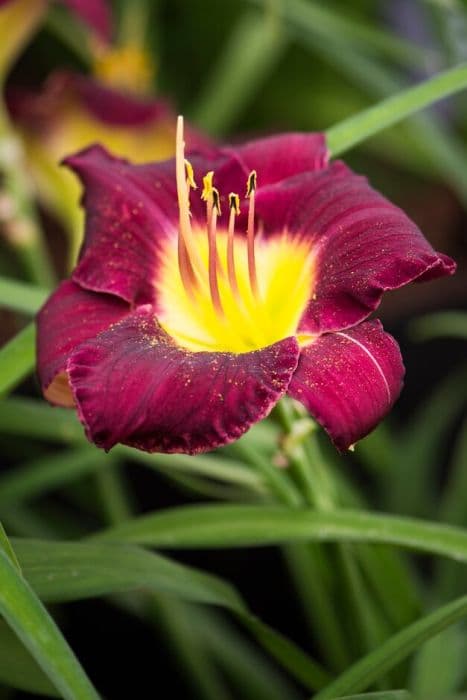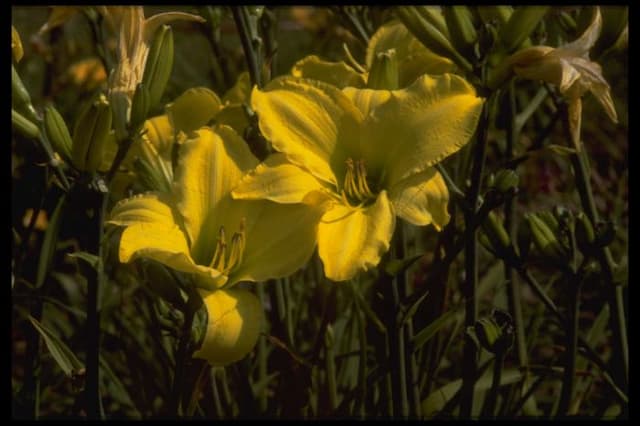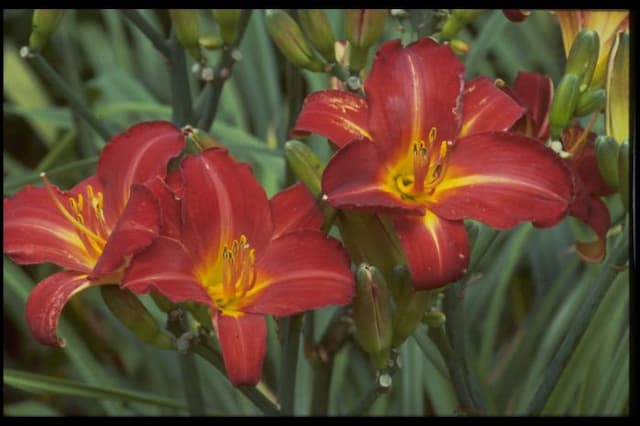New Zealand Flax Phormium tenax

ABOUT
The plant known as New Zealand flax is characterized by its bold and striking form. It sports long, sword-like leaves which are quite rigid and arch out from the base in clumps. The foliage comes in a variety of colors, ranging from deep greens to bronze and even variegated stripes with shades of yellow or cream. The edges of the leaves can be slightly rough, and the leaf surface is often corrugated with texture. During its blooming period, New Zealand flax produces dramatic flower spikes which rise above the foliage. These spikes bear tubular-shaped flowers that are favored by birds and insects. The flowers can come in a range of colors including red, orange, or yellow. Following the flowers, seed pods can form, which are also appealing in their own right, adding further interest to the plant's profile. New Zealand flax has a strong form that can dominate the space it grows in, creating a focal point in gardens or landscapes where it is planted. Its tough leaves are quite resilient and it has an overall exotic and lush appearance, making it a popular choice for ornamental purposes.
About this plant
 Names
NamesFamily
Asphodelaceae
Synonyms
New Zealand Flax, Harakeke, New Zealand Hemp
Common names
Phormium colensoi, Phormium cookianum, Phormium tenax var. atropurpureum, Phormium tenax var. purpureum.
 Toxicity
ToxicityTo humans
New Zealand flax is generally considered non-toxic to humans. However, like many plants, the consumption of large quantities could potentially cause stomach upset or discomfort. There are no widely reported symptoms of poisoning from New Zealand flax, as it is not commonly ingested by humans.
To pets
New Zealand flax is also generally considered non-toxic to pets. As with humans, ingestion of large amounts might lead to gastrointestinal upset, such as vomiting or diarrhea. It is always advisable to prevent pets from eating decorative plants as a precautionary measure, but New Zealand flax is not known for being particularly harmful to animals.
 Characteristics
CharacteristicsLife cycle
Perennials
Foliage type
Evergreen
Color of leaves
Varies
Flower color
Red
Height
6-10 feet (1.8-3 meters)
Spread
5-8 feet (1.5-2.4 meters)
Plant type
Shrub
Hardiness zones
8
Native area
New Zealand
Benefits
 General Benefits
General Benefits- Landscape Aesthetics: New Zealand Flax adds visual interest to gardens with its sword-like, colorful leaves.
- Drought Tolerance: It is highly adaptable to low water conditions, making it ideal for drought-resistant landscaping.
- Erosion Control: The plant's root system helps stabilize soil, reducing erosion on slopes and banks.
- Wildlife Habitat: It provides shelter and sometimes food for certain bird species, like the native New Zealand Tui.
- Low Maintenance: New Zealand Flax requires minimal care once established, making it convenient for gardeners.
- Architectural Form: With its striking form, it can serve as a focal point or accent plant in garden designs.
- Versatility: It is suitable for a range of garden styles, including modern, tropical, and Mediterranean themes.
- Wind Resistance: New Zealand Flax is resistant to strong winds, making it useful in exposed and coastal areas.
- Cultural Significance: It holds traditional value for indigenous Māori people, who use it for weaving and other purposes.
 Medical Properties
Medical PropertiesThis plant is not used for medical purposes.
 Air-purifying Qualities
Air-purifying QualitiesThis plant is not specifically known for air purifying qualities.
 Other Uses
Other Uses- Phormium tenax, commonly known as New Zealand flax, has been traditionally used for textiles; its fibres are extracted and used to make woven items such as mats, baskets, and clothing.
- The plant's fibre is also used in papermaking, particularly for high-quality art papers and specialty papers.
- Archery equipment manufacturers have used New Zealand flax for bowstrings due to its strength and durability.
- Floral arrangements and horticulture practices use the long, blade-like leaves of New Zealand flax for structural garden accent and craft material in creative displays.
- New Zealand flax is often planted for erosion control as its extensive root system helps stabilize soil.
- The nectar from the flowers can be a source of food for birds, while the plant itself provides habitat for certain species of wildlife.
- In boatbuilding practices, the fibres of New Zealand flax have been used as a waterproofing and binding agent for caulking holes.
- Handicraft artisans use the dried leaves to create cords, ropes, and even traditional Maori clothing such as the 'piupiu', a skirt-like garment.
- Sailors in the past have been known to use New Zealand flax to make sails for small boats, utilizing the toughness of the woven fibres.
- Landscape designers incorporate Phormium tenax into urban green space and rooftop gardens for its dramatic foliage and low-maintenance appeal.
Interesting Facts
 Feng Shui
Feng ShuiThe New Zealand Flax is not used in Feng Shui practice.
 Zodiac Sign Compitability
Zodiac Sign CompitabilityThe New Zealand Flax is not used in astrology practice.
 Plant Symbolism
Plant Symbolism- Strength and Durability: The common name of Phormium tenax is 'New Zealand Flax'. Historically, the sturdy leaves of this plant have been used for making ropes and weaving, symbolizing strength and the capacity to withstand tough conditions.
- Resourcefulness: The versatility of New Zealand Flax in various traditional uses, from medicinal to everyday items, represents the ability to adapt and utilize resources effectively.
- Resilience: New Zealand Flax can thrive in a range of environments, making it a symbol of resilience and the ability to survive and flourish against the odds.
- Beauty and Utility: The striking appearance of the plant, with its long, sword-like leaves and colorful flowers, alongside its practicality, symbolizes the balance between aesthetic beauty and usefulness.
- Cultural Heritage: For the Māori of New Zealand, the flax holds significant traditional value associated with their cultural identity and practices, symbolizing a connection to heritage and ancestral knowledge.
 Water
WaterNew Zealand Flax requires moderate watering; it's best to water when the top inch of soil becomes dry. Apply water at the base of the plant to avoid wetting the foliage, using roughly 1 gallon of water for each watering. Water every week during the growing season, but reduce frequency in the winter to every other week, or as needed if the plant is in a cooler environment. New Zealand Flax is relatively drought-tolerant but should not be left completely dry for extended periods.
 Light
LightNew Zealand Flax thrives best in full sun to partial shade. An ideal spot would be one where it receives at least six hours of direct sunlight each day, while being protected from the harsh afternoon sun in hotter climates. However, it can also tolerate lower light conditions, though its growth might be less vigorous.
 Temperature
TemperatureNew Zealand Flax prefers a temperature range between 60 and 70 degrees Fahrenheit, but it can tolerate temperatures down to around 20 degrees Fahrenheit for brief periods. Although it can withstand cooler weather, it should not be exposed to temperatures below 20 degrees Fahrenheit as this can cause damage to the plant. The ideal growing conditions are in a location that remains within these temperature ranges throughout the year.
 Pruning
PruningPrune New Zealand Flax to remove damaged or dead leaves and to keep the plant looking tidy. Pruning is best done in the spring but can be performed any time damaged leaves are noticed. Removing the old foliage also encourages new growth. Annual pruning can promote a healthy and well-shaped plant; cut back the older leaves close to the base of the plant.
 Cleaning
CleaningAs needed
 Soil
SoilNew Zealand Flax prefers well-draining soil with a slightly acidic to neutral pH between 5.5 and 7.0. A mix of loam, compost, and perlite or pumice can provide the right balance of drainage and fertility.
 Repotting
RepottingNew Zealand Flax generally does not need frequent repotting and can be done every 2 to 3 years, or when the plant has outgrown its current container.
 Humidity & Misting
Humidity & MistingNew Zealand Flax tolerates a wide range of humidity levels but prefers moderate conditions; avoid overly dry or excessively humid environments for optimal growth.
 Suitable locations
Suitable locationsIndoor
Place New Zealand Flax near a sunny window and ensure soil is well-draining.
Outdoor
Plant New Zealand Flax in sunny spot with well-drained soil; protect from harsh winds.
Hardiness zone
8-11 USDA
 Life cycle
Life cyclePhormium tenax, commonly known as New Zealand flax, begins its life cycle as a seed, which when germinated in warm, moist soil, grows into a small seedling. The seedling stage is characterized by the emergence of the first leaves, which are initially tender and fragile. As it matures, the plant enters a period of vegetative growth, developing long, sword-shaped leaves up to 3 meters in length and forming thick clumps. After several years, New Zealand flax reaches maturity and produces tall flowering spikes with tubular flowers that attract birds and insects for pollination. Following pollination, seed capsules form and eventually release seeds, completing the reproductive stage. The plant can live for many years, and even when individual leaves die, new ones continue to grow from the plant's base, thus ensuring its longevity.
 Propogation
PropogationPropogation time
Spring to Summer
The New Zealand Flax (Phormium tenax) can generally be propagated by dividing the plant's clumps. Divisions are best done during the spring when the plant is actively growing. To propagate using this method, carefully dig up an established clump and use a sharp spade or knife to cut the clump into smaller sections, each with at least one growing point. It's crucial to replant these divisions promptly, keeping them at the same depth they were growing originally and watering them well to help establish the new plants. This straightforward technique maintains the varietal characteristics of the parent plant and allows for a relatively quick establishment of new plants in the garden.









